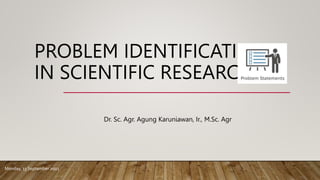This document discusses identifying research problems in scientific research. It begins by defining a research problem as the issue being addressed in a study, such as a condition to be improved or a troubling question. A research problem helps narrow the topic and is compared to other parts of the research process like the purpose and questions. Good research problems set the scope of the study and tie the research to goals and actions. The document provides steps for defining a research problem, such as observing to identify key concepts and reviewing influencing factors. It also differentiates between quantitative and qualitative research problems and provides guidance for writing an effective problem statement.
















